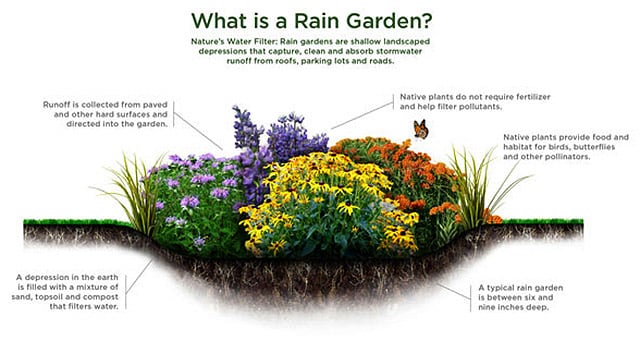Stormwater is water that used to soak into the ground and become ground water prior to development but runs off of impervious surfaces, collecting pollutants until it ultimately enters our surface waters. These pollutants include trash, chemicals, sediment, and oils among many others. Population growth and development rates are increasing the amount of pollutions and the volume and rate of runoff from impervious surfaces. Stormwater runoff pollution causes changes in hydrology and water quality that then result in habitat modifications, increased flooding, decreased aquatic biological diversity, and increased sedimentation and erosion. Best management practices (BMPs) like rain gardens filter out pollutants and/or prevent pollution by controlling it at its source.
Shallow, depressed landscapes planted with native plants, rain gardens both filter and process pollutants like oil, fertilizer, pesticides, and chemicals from stormwater before it reaches local waterbodies. Rain gardens are constructed using amended soils for infiltration and native plants tolerable of wet and dry conditions for evapotranspiration, and thus they do not require drainage pipes. The native plants typically used in these gardens are grasses and perennials; for a list of species native to ohio, see Ohio Department of Natural Resources (ODNR) lists by clicking the link.
Benefits of Rain Gardens: Rain gardens provide a number of environmental and aesthetic benefits for homeowners. Typically absorbing water from rain events in less than one day, rain gardens provide flooding and puddling prevention. These gardens dry out quickly enough to prevent mosquito reproduction as well. As mentioned before, rain gardens absorb and process stormwater, helping keep pollutants out of local waters like Tinker’s Creek and increasing groundwater recharge. Because of this, more water is kept out of water treatment plants and the emissions from these plants are reduced. In communities with combined sewer systems, the savings from reduced combined sewer overflows is estimated at $0.0002 per gallon of stormwater captured. Considering five rain gardens can divert 53,000 gallons of stormwater from sewage systems, these savings can be very significant. Rain gardens also provide habitat and food for pollinators and other animals. One last benefit of these beautiful gardens is an increase in property values. Due to their aesthetic appeal and flooding benefits, rain gardens are estimated to increase property values by 2-8% and rental rates by 7%.
Before You Build: Prior to installing a rain garden on your property, check local and state requirements for size, structure, or permitting and approval procedures. In addition, identify which areas you want to drain to your rain garden. You want to ensure that the rain garden is placed so each of these areas will drain naturally to the garden via gravity. To have each of the desired areas draining to your rain garden, you may need to install multiple gardens. Choose a location for the garden with a slope less than 10% to prevent erosion and an area where overflow will be kept away from your home and neighboring properties. Areas to avoid when choosing a location for your rain garden include: within 10 feet of a building foundation, near the edge of steep slopes or bluffs, over underground utilities, near an existing reserve septic drainfield or tank, in low spots that do not drain well, in areas that require disturbing healthy native soils and vegetation, where there is high groundwater in winter, or within 100 ft of drinking water wells. You also want to consider the drainage properties of your soil when selecting a depth.
Building a Rain Garden: Consider the inflow and overflow of your rain garden, and build these areas with protection against erosion like a rock or vegetation lining. The recommended ponding depth for rain gardens is between 6 and 12 inches with a minimum of 6 inches for overflow containment depth. The replacement or amended soil you are using should be 12-24 inches in depth, and your rain garden should have a flat, level bottom. If locating the rain garden in a lawn area, edge your rain garden to prevent grass from spreading into the garden area.
Maintenance: Maintaining your rain garden is relatively easy. At minimum, you should mulch your rain garden yearly to control weeds and replenish organic material. During the summer months, you should water your garden every 2-4 days in the first year and every 4-7 days in the second. After a few years, rain gardens with native plants should require little to no additional watering. Weeding should always be done by hand, and less weeding will be required in the years subsequent to creation of your rain garden.
For more information on rain gardens, contact Tinker’s Creek Watershed Partners. In addition, much of the information in this article was retrieved from this guide created by the State of Washington Department of Ecology!


